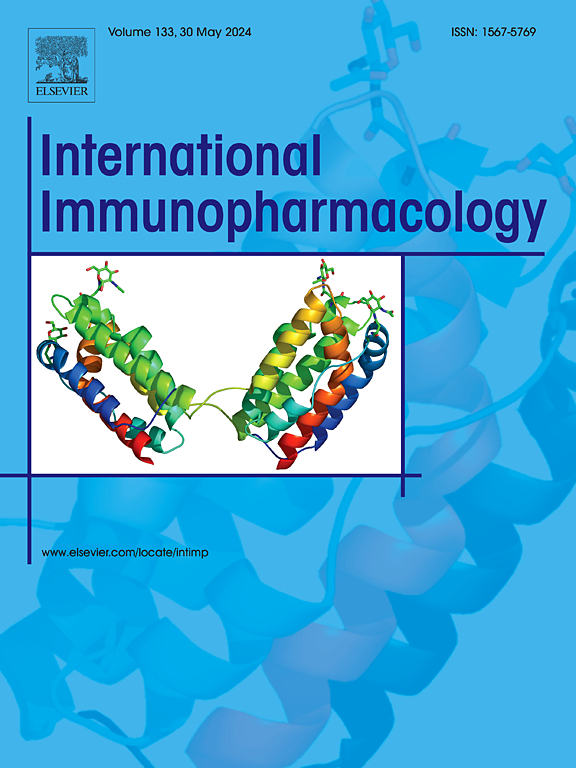新鱼腥草素钠对腹腔念珠菌病模型小鼠巨噬细胞活化及抗真菌感染的预防作用
IF 4.8
2区 医学
Q2 IMMUNOLOGY
引用次数: 0
摘要
滥用免疫抑制剂会对免疫系统造成损害,而共生白色念珠菌的病理性增殖和易位可导致免疫功能低下人群的腹部感染。本研究建立小鼠腹膜白色念珠菌感染模型,通过分析免疫细胞比例、腹膜巨噬细胞极化、真菌组织负荷变化和组织学,探讨新鱼腥草素钠(SNH)预防应用的效果,数据显示,根据机体的免疫炎症状态,预防性应用SNH具有吞噬和调节免疫的双重抗感染作用。体外中性红、集落计数、细胞头阵列、RT-qPCR、western blot、抑制剂处理、RAW264.7巨噬细胞活性氧(ROS)和一氧化氮(NO)生成检测表明,SNH可以通过TLR2/p38/NF-κB途径刺激肿瘤坏死因子-α (TNF-α)和CC基元配体2 (CCL2)的产生和ROS和NO的释放。综上所述,我们的数据为预防使用外源性SNH治疗白色念珠菌感染提供了创新的见解。本文章由计算机程序翻译,如有差异,请以英文原文为准。
Prophylactic application of sodium new houttuyfonate to regulate macrophage activation and antifungal infection in intra-abdominal candidiasis model mice
The abuse of immunosuppressants causes damage to the immune system, while the pathological proliferation and translocation of symbiotic Candida albicans can result in abdominal infection in immunocompromised people. In this study, we established a mouse peritoneal C. albicans infection model and investigated the effects of preventive application of Sodium New Houttuyfonate (SNH) by analyzing the proportion of immune cells, polarization of peritoneal macrophages, changes in fungal tissue load, and histology, and the data showed prophylactic SNH administration yields a double anti-infection effect in phagocytosis and regulation of immunity according to the immune inflammatory states of the body. In vitro, neutral red, colony counting, cytometric bead array, RT-qPCR, western blot, inhibitor treatment, and detection of reactive oxygen species (ROS) and nitric oxide (NO) production on RAW264.7 macrophages showed SNH can stimulate the production of tumor necrosis factor-alpha (TNF-α) and C![]() C motif ligand 2 (CCL2) and the release of ROS and NO through a TLR2/p38/NF-κB pathway. Taken together, our data provide an innovative insight into the prevention use of exogenous SNH for the treatment of C. albicans infection.
C motif ligand 2 (CCL2) and the release of ROS and NO through a TLR2/p38/NF-κB pathway. Taken together, our data provide an innovative insight into the prevention use of exogenous SNH for the treatment of C. albicans infection.
求助全文
通过发布文献求助,成功后即可免费获取论文全文。
去求助
来源期刊
CiteScore
8.40
自引率
3.60%
发文量
935
审稿时长
53 days
期刊介绍:
International Immunopharmacology is the primary vehicle for the publication of original research papers pertinent to the overlapping areas of immunology, pharmacology, cytokine biology, immunotherapy, immunopathology and immunotoxicology. Review articles that encompass these subjects are also welcome.
The subject material appropriate for submission includes:
• Clinical studies employing immunotherapy of any type including the use of: bacterial and chemical agents; thymic hormones, interferon, lymphokines, etc., in transplantation and diseases such as cancer, immunodeficiency, chronic infection and allergic, inflammatory or autoimmune disorders.
• Studies on the mechanisms of action of these agents for specific parameters of immune competence as well as the overall clinical state.
• Pre-clinical animal studies and in vitro studies on mechanisms of action with immunopotentiators, immunomodulators, immunoadjuvants and other pharmacological agents active on cells participating in immune or allergic responses.
• Pharmacological compounds, microbial products and toxicological agents that affect the lymphoid system, and their mechanisms of action.
• Agents that activate genes or modify transcription and translation within the immune response.
• Substances activated, generated, or released through immunologic or related pathways that are pharmacologically active.
• Production, function and regulation of cytokines and their receptors.
• Classical pharmacological studies on the effects of chemokines and bioactive factors released during immunological reactions.

 求助内容:
求助内容: 应助结果提醒方式:
应助结果提醒方式:


